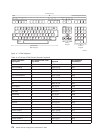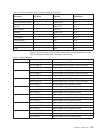
Table 13. Editing Keypad (continued)
Keyword Hex Character Transmitted Control Character Description
Notes:
1. This sequence is a shortened version of the 7-bit sequence. It is only presented when operating in 8-bit mode,
which can be called by the remote VT220 host or server, or it may be specified in the ASCOPRMOD parameter
of the STRTCPTELN CL command.
Table 14 shows the keywords that are handled locally within the AS/400 Telnet
client session.
Table 14. Local AS/400 Function Keys
Keyword Hex Character Transmitted Control Character Description
*SENDWOCR None
1
VT100 and VT220 control key
*SHIFTDSP None
2
Shift display
*HIDE None
3
Hide input
*KEYPRI None
4
Call primary keyboard mapping of 5250 function keys
*KEYALT None
4
Call alternate keyboard mapping of 5250 function keys
Notes:
1. The data that has been typed is sent to the remote system without appending the carriage return and line feed
characters.
2. The *SHIFTDSP keyword is used when the remote system has selected 132-column mode and the 5250 terminal
only has 80 columns. When the function key that has the *SHIFTDSP function assigned to it is pressed, the
rightmost 80 columns or the leftmost 80 columns are shown depending on what is currently on the display.
3. The *HIDE keyword is used when the user does not want typed characters shown on the display, for example,
when typing a password.
4. The *KEYPRI and *KEYALT keywords signal the TELNET client session to dynamically call the respective
full-screen ASCII keyboard map. The *KEYPRI mapping calls the primary keyboard map, and *KEYALT calls the
alternate keyboard map. By default, they are assigned to the Page Down (Roll Up) and the Page Up (Roll Down)
5250 function keys. When the requested keyboard map is already in effect, no action is taken.
VTxxx—National Language Support
There are alternative methods of selecting character mapping between the client
and server systems with VTxxx emulation. These are:
v Coded character set identifier (CCSID)
v Multinational mode
v National mode
If none of these modes is suitable, you may set up and specify your own
user-defined mapping tables.
Note: VTxxx support is limited to a subset of single-byte character set (SBCS)
languages. A list of the supported languages is found later in this section.
Any of these supported single-byte language translation tables can be
modified to map any single-byte language that is preferred, then identified in
the appropriate parameter for starting Client Telnet.
Mode selection is done with the CCSID parameter of the Start TCP/IP Telnet
(STRTCPTELN) command. The incoming ASCII/EBCDIC table (TBLVTIN) and
outgoing EBCDIC/ASCII table (TBLVTOUT) parameters of this command allow the
Chapter 5. Telnet Client 179


















